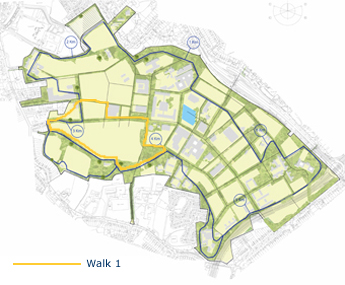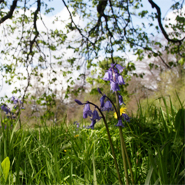Posted: 23 July 2008
Enhancing the campus woodland for present and future generations
The woodland boundaries, tree avenues, and walled gardens visible around the UCD Belfield campus today pay testament to the 18th and 19th century period houses and associated lands from which the campus has evolved. As the development of the Belfield campus has increased in pace over more recent years, the development and protection of the campus woodland resources are particularly important to ensure viable tree cover is maintained for present and future generations.
As part of a sustainable strategy, the university is currently enhancing its woodland boundary. This development will include the phased creation of a jogging, cycling and walking track stretching 6.5km around the campus boundary. The first of four self-contained woodland walks that will be encompassed by the wider 6.5km walk is due for completion at the end of August 2008 in time for the beginning of the new academic term. This walk will measure approximately 2.15km in length beginning and ending at the UCD Sports Centre where information boards on the walk will be situated.

As part of other ongoing projects, new areas of woodland have been planted by UCD in Belfield each year since 1998. The species of trees planted in each location reflect consideration of those which had originally been planted in the area at the time when they were private estates. Approximately 25,000 trees have been planted increasing the overall woodland coverage on campus from 14 acres to almost 22 acres. The intention is to continue to increase this woodland cover over the coming years.
“There has been a conscious decision to collectively increase the number of trees on campus. In tandem with the preservation of the existing trees and landscape, there has been a drive to enhance and add to the tree avenues and wooded areas. This in turn will improve the campus environment and boost the overall quality of life for all those who spend time on the Belfield campus,” says Eamonn Ceannt, UCD Vice-President for Capital and Commercial Development.
The woodland areas of the Belfield campus include:
Belfield Wood – 4.5 acres of woodland running north/south of Belfield House up to the Stillorgan Dual Carriageway, about 1.5 acres of which has been planted since 1998. The dominant tree species in this wood are Fagus sylvatica (beech), Tilia europaea (lime), and Aesculus hippocastanum (horse chestnut), with only a few remaining Quercus robur (oak) and Pinus sylvestris (scots pine)
Oakland Walk – a double line of oak trees which runs from the UCD Bowl to the rear of the UCD Veterinary Sciences Building. On the northern boundary, adjacent to the existing mature trees, a substantial area has been planted with a mixture of young trees to enhance the boundary woodland. There area also has many other important ecological features including a pond, filter beds, a pine copse and a wildflower meadow. It is a valuable recreational and wildlife area with a broad range of biodiversity at the centre of a university campus
Rosemount Wood – approximately 3 acres of woodland located to the rear of the UCD crèche. The dominant species in this woodland are Fagus sylvatica (beech), Fraxinus excelsior (ash), and Acer pseudoplatanus (sycamore) with some Aesculus hippocastanum (horse chestnut), Quercus ilex (holm oak) and Tilia europaea (limes) also present. The woodland offers an important habitat for wildlife and it is not used intensively as an amenity area
Merville Wood – a wooded area of approximately 1 acre immediately west of Merville House consisting of mature Fagus sylvatica (beech), Quercus robur (oak), Tilia europaea (lime), Populus nigra (popular), Prunus avium (bird cherry) Acer pseudoplatanus (sycamore) and Fraxinus excelsior (ash)
Fosters Avenue Wood – a long narrow strip of woodland (approximately 3 acres) running along Fosters Avenue. The main trees in this wood include Quercus robur and Quercus petraea (oak), Acer pseudoplatanus (sycamore), Salix spp (willow), Fraxinus excelsior (ash), Tilia x europaea (lime), Aesculus hippocastanum (horse chestnut) and Fagus sylvatica (beech)
Bursars Wood – a new area of woodland planted in 2004 creating links between 3 other established woodland areas (Belfield Wood, Merville Wood, and Fosters Avenue Wood). Quercus robur (oak), Fagus sylvatica (beech) and Genus juglans (walnut) have been planted to become the dominant trees, with Genus betula (birch), Prunus avium (bird cherry), Genus salix (willow) and Viburnum opulus guilder rose in the under storey. The linkages between the existing woodlands will encourage greater biodiversity on campus.
The UCD Woodlands Walkway project was awarded €10,000 by the UCD Alumni Fund in February 2008. The UCD Alumni Fund annually raises funds from graduates and friends of the university to support UCD students by enhancing the quality of their academic, social, sporting and cultural experience.

